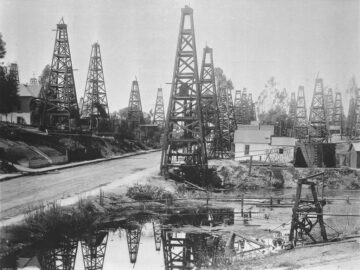Jonathan Blake at Noema:
 Baldwin Hills juts up 500 feet from the flat expanse of the Los Angeles Basin, the result of millennia of seismic activity along the Newport-Inglewood Fault, a dextral strike-slip fault that runs for 47 miles from Culver City through Signal Hill to Newport Beach. The fault, formed some 30 million years ago when the Pacific plate collided with the North American plate (an intersection that now sits at the San Andreas Fault), expresses on the surface as a series of low, irregular hills. Below the surface, seismic activity created a series of oil and gas reservoirs, including the Inglewood Oil Field.
Baldwin Hills juts up 500 feet from the flat expanse of the Los Angeles Basin, the result of millennia of seismic activity along the Newport-Inglewood Fault, a dextral strike-slip fault that runs for 47 miles from Culver City through Signal Hill to Newport Beach. The fault, formed some 30 million years ago when the Pacific plate collided with the North American plate (an intersection that now sits at the San Andreas Fault), expresses on the surface as a series of low, irregular hills. Below the surface, seismic activity created a series of oil and gas reservoirs, including the Inglewood Oil Field.
LA’s geologic past is more than a niche interest for rockhounds and petroleum engineers. Deep time processes shaped the city’s contemporary urban geography, and still do. Rather than grow along transportation lines — the typical pattern of residential sprawl during the 19th and 20th centuries — LA’s new developments often followed oil strikes. Subterranean discoveries helped to produce the city’s famous suburbanized sprawl — a network of “black gold suburbs” that oozed away from the city’s urban core.
more here.
Enjoying the content on 3QD? Help keep us going by donating now.
